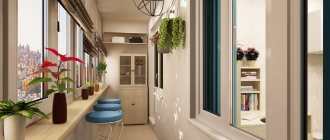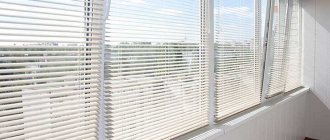Just as no apartment or house is complete without windows, windows are nowhere without window sills, the exception being floor-to-ceiling panoramic glazing, when part of the wall is replaced with double-glazed windows. In all other cases, a window sill is a mandatory window unit, a decorative element, and free space that can be used in various ways. Today, this interior element is made from various materials, and the white classic is generously diluted with bright shades, and the shape is not always a rectangle.
Types of window sills
The window sill board has several functions:
- combining the window frame and the wall;
- preventing heat leakage;
- design of the transition from external to internal space.
Traditionally, our grandmothers and mothers used window sills as indoor greenhouses for decorative potted plants, and even today many grow not only flowers, but also fresh herbs and seedlings on their windows. The operating mode will depend on how this area is intended to be used. Therefore, before deciding which window sill to install, it is worth considering all the varieties offered by the market.
What is important to know
The main purpose of the window sill is to increase the width of the air gap near the glazing. This way the heat is retained better. This is precisely why window sills have been installed for a very long time. Modern designs retain the heat coming from radiators indoors and prevent the flow of cold outside air from entering the house. They also help to actively circulate air flow inside the room.
Decorative problems are also solved. They visually “tie” the window frame to the overall design of the room, combine these elements, and, if chosen correctly, also decorate the interior.
In addition, depending on their size, window sills perform utilitarian functions. For example, they are used as a shelf for flowers or books, a tabletop or a comfortable sofa. Window sills and countertops are especially in demand among owners of small apartments. A place to work, a kitchen work area, and a mini-workshop will be organized here.
Instagram kand.wood
Instagram woodcraft_mos
- Storage systems
10 ideas for practical use of a window sill
Window sills made of plastic
This is the most common and affordable type of window sill board, which is due to the popularity of PVC windows, which come with plastic window sills. Most often they are white, but since colored profiles are becoming more widespread, you won’t surprise anyone with window sills in brown tones; imitation of a wooden or stone surface is popular. The advantages of plastic include accessibility, lightness, moisture resistance, strength, rigidity and durability. Also, plastic window sills are considered the “warmest” due to their hollow chamber structure.
However, plastic can be deformed due to temperature changes, and scratching it is not difficult. Another drawback is that light-colored window sills quickly get dirty, and it is quite difficult to remove dirt from the textured surface without using abrasives or chemicals. When you intend to use the window sill as a work area, for example, in the kitchen, it is worth ordering an improved version - with a heat-resistant and impact-resistant coating.
Basic care rules
All products made from natural wood require special care, and a custom-made wooden window sill is no exception. To ensure that the structure retains its original appearance for many years, we recommend adhering to the following rules:
- Carry out periodic inspections for moisture or cracks;
- regularly treat the surface with varnish, following the manufacturer’s advice;
- clean the varnished surface from dirt exclusively with a damp cloth, avoiding the use of substances containing acid, alcohol or gasoline, as they destroy the structure of the wood;
- Gently water indoor flowers on the windowsill.
rsk-factory.ru
In addition, it should be remembered that all construction work in the room (pouring the floor, plastering the walls, painting, etc.) must be carried out before installing the window block and window sill.
Wooden window sills
Before the total dominance of plastic in our houses, almost all window sills were wooden, less often made of thick plywood. Today, a solid wooden window sill is an expensive pleasure, especially if it is not homemade, but a custom-made product. A budget option for wooden window sills is made of coniferous trees, pine, spruce or larch. After sanding, staining and varnishing/painting, they look quite rich, but cannot boast of mechanical resistance. More valuable species, such as oak, beech or ash, look great without tinting; it is enough to reveal their structure by sanding and colorless oil/wax. It takes a lot of effort to scratch or push them, but the price tag is impressive.
The most high-status and expensive window sills are carved from mahogany, ebony and rosewood, but these are already piece products that require appropriate surroundings. Another type of window sills, classified as wooden, is made from laminated board; the multilayer structure is assembled in such a way that the top layer is resistant to wear and damage. But both wooden and panel window sills must be protected from direct contact with water and high humidity. When cleaning, the use of abrasive agents is not allowed, and the oil or wax coating must be periodically renewed.
Is it worth doing the installation yourself?
Installers are invited to replace a plastic window sill with a wooden one. But you can do the work yourself. Such an installation will not only save money, but will also serve as a symbol of your thriftiness and skill. Who doesn’t want to have a piece of personal pride with which they can impress guests and acquaintances, especially since the installation diagram is very simple.
It is also important that you can choose the material for installing the wooden window sill yourself. In this case, the best wood will be used, and not a budget option. Reliability and strength are the main qualities of a window sill. It should last a long time, so the choice of wood is a key point in the work.
You can also adjust plastic windows with your own hands. This is a one-time job, but you will use it for a long time.
How to install a comb for plastic windows and which system is better to choose.
Window sills made of MDF and chipboard
Almost all the furniture around us is successfully made from these materials; it is not surprising that window sills made of wood composite are also found. They are quite popular due to their affordable cost and attractive appearance; thanks to lamination, they can imitate any wood and other natural materials, while veneered MDF is generally impossible to distinguish from wood. However, laminated boards are preferable, as they are resistant to moisture, and the mechanical resistance of this film is higher.
However, if the coating is damaged, the window sill may swell when exposed to water, and if you place a hot pan on it without a backing, you can actually get a stain of a different color. During installation, it is important not to damage the integrity of the edges and lay a special tape between the wall and the slab.
In harmony with the slopes
The same material of the slopes and window sill gives the window design a resemblance to a painting. This solution allows you to beautifully present the view outside the window and make it a full participant in the interior. Wood and stone look great as such a “frame”. Decorating the opening with wood is more suitable for apartments overlooking a garden, park or forest - it will be in harmony with the natural environment.
In this project, the wooden window frame was also supported by an open shelving unit made of the same material. Studio Diagonal, architect Egor Egorychev, photographer Natalya Melikova
The city landscape will be effectively framed by window slopes with a window sill made of dark stone. Little Space studio, designer Evgenia Shama
Window sills made of natural stone
As well as from an array of valuable species - an expensive, exclusive pleasure not for every interior, it is unlikely that a stone window sill will fit into a budget kitchen or living room with a standard furnishings. But this in no way detracts from the merits of the stone - it is almost eternal and looks amazing. Window sills are usually cut from marble, granite and onyx; if you have financial resources, a window sill in the kitchen can be combined with a stone countertop, and in the room - with a fireplace portal. From a visual point of view, marble wins - it has the widest range of colors, you can choose a board to suit any interior.
However, it is also the most problematic: a relatively soft surface, compared to granite, which can be damaged not only mechanically, but also by spilling colored liquid. Marble also gets dirty quickly and requires constant care and polishing, and the protective coating applied in production requires regular updating. But granite, although it doesn’t come in a variety of colors, is very durable, it’s difficult to scratch or chip, and it’s easier to care for. As for onyx, this is a godsend for designers due to the stone’s ability to transmit light - illuminated window sills will leave few people indifferent.
How to do it yourself?
Wood is easy to process, so it’s possible to make it yourself. To do this, you need to select the material and familiarize yourself with the details of the process.
Materials and designs
The location of the window sill implies regular exposure to sunlight, moisture, and high temperatures from the battery during the heating season. Therefore, you need to choose more durable materials: glued, tongue-and-groove or milled wood. Designs can be of the following type:
- Solid - one wooden board is used, which is processed to obtain the required shape.
- Milled - consists of solid elements with grooves on one side and ridges on the other. There are several grooves on the underside of the board to prevent the material from deforming in the future.
- Tongue-and-groove - has tongue-and-groove joints. There are holes in the bottom for air circulation.
- Glued lamella - different-sized pieces of wood are glued together under high pressure.
The highest quality materials for manufacturing are oak, beech, and pine.
The most economical option is to use blocks made of sanded chipboard and MDF. These are pressed wood materials that are covered with a polymer film.
From a cut tree
For manufacturing, you need to choose well-dried boards that are free of knots or other defects. Manufacturing stages:
- The board must be planed on all sides, then sanded and polished so that the original material is even and smooth.
- Then it must be coated with an antiseptic to prevent the appearance of fungus, bacteria, and pests.
- Small grooves up to 10 mm wide are cut out at the bottom of the board, and you need to step back from the front part by 10-20 mm.
- The board must be given a shape and a suitable length.
If not a solid tree is used, but component parts, then they are glued together, connected with dowels or dowels.
Attention
The length of the wooden window sill should be 10–15 cm greater than the width of the window opening, and the length of the part protruding into the room should be at least 6–7 cm.
Window sills made of artificial stone
In appearance, it is impossible to distinguish them from natural ones, but they are still lighter and cheaper, while being strong, durable, resistant to damage and high temperatures. Composites today are not inferior to natural materials either in appearance or in characteristics, which explains their growing popularity. Unlike marble, artificial stone cannot be damaged by spilling coffee or dropping something heavy. And the artificial surface does not need regular polishing and renewal of the protective coating; wet cleaning is sufficient. But it is not recommended to clean such window sills with an abrasive, like all others, this is the only thing that can damage them. Another undoubted advantage of such window sills is the ability to decorate all windows in the same style with identical boards; with natural stone this is unrealistic not only because of the price, but also because of the uniqueness of the textures.
When choosing a window sill, special attention is paid to the material from which it is made, the color scheme, which should be combined with the rest of the interior, and the mode of operation. But another important factor is the thickness of the board - the more intensive the intended use, the thicker the window sill should be. Especially if its width allows you to place a large number of flower pots, arrange a seat/bed or a play area for children on it.
The market has a large selection of not only window sills, but also countertops for work areas, as well as coffee tables. And the craftsmen of our portal have learned to cast furniture from concrete, including console window sills. The video is about homemade furniture.
Preparing the base of the wall
The polyurethane foam must come into direct contact with the wall material. Therefore, the base of the opening is cleared of construction debris and foam that has excessively protruded when foaming the space between the frame and the walls. The foam is also cut out from under the lower window profile to a depth of 2-3 cm to partially pinch the window sill fabric by the window structure.
If the distance between the lower plane of the installed window sill and the base of the wall is less than 1 cm, a recess up to 70 mm wide and 20-30 mm deep is cut into the wall to form a foam seam on which the plastic panel will lie.
How to level the surface?
Due to improper installation or violation of operating rules, the window sill may become warped. Alignment may be required during installation. You can level it with the following tools:
- perforator;
- polyurethane foam;
- level;
- hammer;
- wooden wedges.
The alignment process consists of several steps:
- It is necessary to break the wall under the window sill and where it adjoins the slopes - the entire structure must move freely up/down.
- To level the wedges, you need to place them near the slopes and in the middle of the window. You need to start selecting the size of the wedges from the edges, and at the end move to the middle of the structure. All deviations must be eliminated by checking with a level.
- The gap between the wedges is filled with mounting foam or cement mortar. There is no need to save on foam so that the structure does not sag in the future.
- After 12 hours, the remaining foam is cut off, the bottom of the slopes is plastered and puttied.











